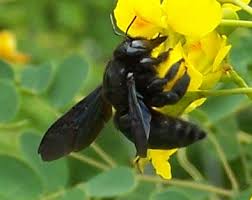Why re-introduce black bee?
Despite the color that gave it its name, the black bee (Apis mellifera mellifera) does not come from the African continent! Its territory is European and more precisely on a very wide area ranging from the chain of the Pyrenees to Poland. Since the dawn of time, the black bee is perfectly adapted to the climate of this great geographical area. A century ago, it was the only species of bee present in the hives. It was then called the common bee, perfectly adapted to its climatic context.

A species abandoned by beekeepers producing
.jpg)
It now represents only 10% of the honey bee population in France!
In order to save it, fifteen conservatories were created in the hexagon by enthusiasts. The first was the island of Ouessant in 1989. Remote from the continent and enjoying a pesticide-free environment, this Breton sanctuary is a reference in this matter.
But this is not enough because for more than 50 years the black bee is neglected by the bee world preferring it more productive species of import.
In the 60s it was the yellow bee (apis mellifica lingta) the beautiful Italian, who had the honors. Then in the years 70-80 it was the gray bee (apis mellifica caucasica) the needy of the Caucasian region that was in fashion.
The brown bee (apis mellifica carnica) of Slovenia had its glorious era in the 90s. In order to obtain more and more important crops, the beekeepers selected bees producing very populous colonies, starting quickly in spring, swarming as little as possible and sweet as lambs ... the bee ideal in some way!
Nowadays it is the Buckfast @ (registered trademark) which mainly populates the apiaries.
Created by man, crossing the different species in laboratory, it requires a continuous selection in order to accumulate the maximum qualities of the different lines from which it is derived, while rejecting their defects.
A species that is perfectly adapted to its environment
An ideal morphology
.jpg)
The black bee is quite large, its color is very dark for better absorption of the sun, its abdomen is large and voluminous. It has many long hairs that facilitate the transport of pollen in bad weather. Its wings and chest muscles are powerful allowing it to work in the wind. A population adapted to capricious meteors Of course, the queen of black bees does not rush to lay eggs at the first rays of the sun. The colony therefore develops less rapidly at the beginning of the season than the other species. But in the event of rotten spring, there will not be an army of foragers to feed in the expectation of a weather more mild. A colony of black bees is obviously inferior in number to a colony of brown or yellow bees, but it has fewer mouths to feed, so honey reserves decrease less in the event of bad weather.
Winter resistance and uneven rusticity
The black bee is the one that consumes the least food in the winter. It must be said that it has the ability to accumulate fat, thanks to its genetic heritage that goes back to the last period of glaciation a few million years ago. In comparison, the yellow bee of Mediterranean origin is chilly and needs more calories to warm up.
It is therefore the most resistant species in winter.
Rustic, it also has the advantage of managing very well without the help of the man who does not need to feed it outside very exceptional conditions.
A brave fighter
The black bee is also a courageous fighter against predators and intruders, which is a good sign of defense against various parasites and diseases. But no excessive fears to have at this level, the beekeeper who works gently while respecting his bees has nothing to fear. It is no more likely to be stung by yellow bees, gray or black if it adopts a respectful attitude of its colonies. Some days, even before reaching the hive, a listening beekeeper knows that it is not the right day, when the bees are nervous, it is better to postpone the planned intervention to the next day. In short, no need for genetic manipulation to create docile bees, it is simply necessary that the man adapts to the bee and not the reverse.
All these intrinsic qualities of the black bee therefore make it the naturally best suited to its environment over its geographical area.
@minnowpond has voted on behalf of @minnowpond. If you would like to recieve upvotes from minnowpond on all your posts, simply FOLLOW @minnowpond. To be Resteemed to 4k+ followers and upvoted heavier send 0.25SBD to @minnowpond with your posts url as the memo
Good article. I invite you to my profil about beekeeping, bees ; )